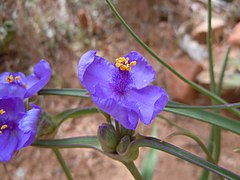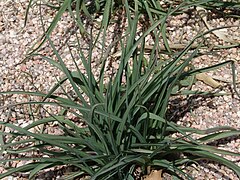Tradescantia occidentalis
| Western spiderwort | |
|---|---|

| |
| Scientific classification | |
| Kingdom: | Plantae |
| Clade: | Tracheophytes |
| Clade: | Angiosperms |
| Clade: | Monocots |
| Clade: | Commelinids |
| Order: | Commelinales |
| Family: | Commelinaceae |
| Genus: | Tradescantia |
| Species: | T. occidentalis
|
| Binomial name | |
| Tradescantia occidentalis (Britton) Smyth
| |
| Varieties | |
| |
Tradescantia occidentalis, the prairie spiderwort[3] or western spiderwort, is a plant in the dayflower family, Commelinaceae. It is common and widespread across the western Great Plains of the United States, as well as in Arizona, New Mexico, southern Utah, and Sonora, but is listed as a threatened species in Canada.[4][5][6]
Like in a few other species of Tradescantia, the cells of the stamen hairs of Western spiderwort are normally colored blue, but when exposed to neutron radiation or other forms of ionizing radiation, the cells mutate and change color to pink.[7] Thus the plant can be used as a bioassay for radiation.

Gallery
[edit]-
Seeds
References
[edit]- ^ Maiz-Tome, L. (2016). "Tradescantia occidentalis". IUCN Red List of Threatened Species. 2016: e.T64325500A67731117. doi:10.2305/IUCN.UK.2016-1.RLTS.T64325500A67731117.en. Retrieved 15 July 2023.
- ^ NatureServe (2024). "Tradescantia occidentalis". Arlington, Virginia. Retrieved 2 February 2024.
- ^ a b USDA, NRCS (n.d.). "Tradescantia occidentalis". The PLANTS Database (plants.usda.gov). Greensboro, North Carolina: National Plant Data Team. Retrieved 18 December 2009.
- ^ "Tradescantia occidentalis". World Checklist of Selected Plant Families (WCSP). Royal Botanic Gardens, Kew.
- ^ "Tradescantia occidentalis". County-level distribution map from the North American Plant Atlas (NAPA). Biota of North America Program (BONAP). 2014.
- ^ "Species Profile: Western Spiderwort". Species at Risk Public Registry. Government of Canada. 13 May 2009. Retrieved 17 December 2009.
- ^ Dennis, J. A. (April 1976). "Somatic Aberration Induction in Tradescantia Occidentalis by Neutrons, X- and Gamma-radiations". International Journal of Radiation Biology. 29 (4): 323–342. doi:10.1080/09553007614550381. PMID 1084866.
External links
[edit] Media related to Tradescantia occidentalis at Wikimedia Commons
Media related to Tradescantia occidentalis at Wikimedia Commons Data related to Tradescantia occidentalis at Wikispecies
Data related to Tradescantia occidentalis at Wikispecies
Text is available under the CC BY-SA 4.0 license; additional terms may apply.
Images, videos and audio are available under their respective licenses.









